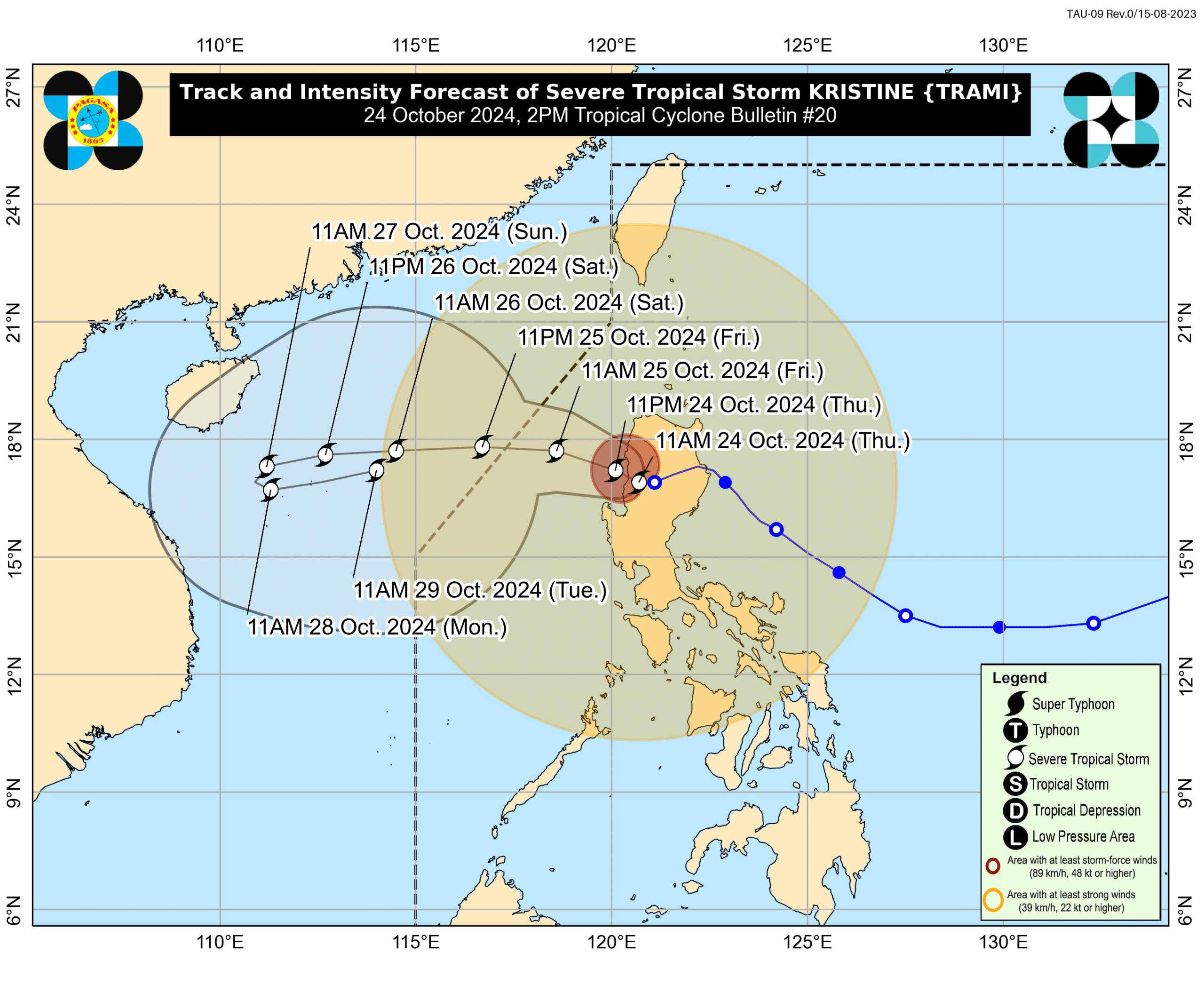
Track and Intensity Forecast of Severe Tropical Storm Kristine as of 2 p.m., October 24, 2024 (Image from DOST-Pagasa / Facebook)
MANILA, Philippines — Metro Manila and portions of Cavite, Rizal, and mainland Quezon were reinstated under Tropical Cyclone Wind Signal No. 2 on Thursday evening due to the “short-term wobbling” in the motion of Severe Tropical Storm Kristine (international name: Trami).
The Philippine Atmospheric, Geophysical and Astronomical Services Administration (Pagasa), in its 8 p.m. bulletin on Thursday, disclosed the matter, noting that Kristine continues to move slowly toward the Lingayen Gulf and is now over the coastal waters of Bacnotan, La Union.
Pagasa said Kristine has maximum sustained winds of 95 kilometers per hour (kph) near the center, gustiness of up to 145 kph, and it is moving westward slowly.
READ: LIVE UPDATES: Severe Tropical Storm Kristine
“[It] is forecast to move westward or west northwestward over the West Philippine Sea and exit the Philippine Area of Responsibility (PAR) on Friday (October 25) afternoon,” said Pagasa.
“In the extended outlook, there is a developing forecast situation wherein Kristine will be looping over the West Philippine Sea on Sunday and Monday and move eastward or east northwestward towards the general direction of the PAR region. However, this scenario heavily depends on the behavior of the weather disturbance east of the PAR region which is expected to develop into a tropical depression within the next 24 hours,” it added.
Below is the complete list of areas placed under Signal No. 2 due to Kristine:
- Cagayan including Babuyan Islands
- Isabela
- Quirino
- Nueva Vizcaya
- Apayao
- Kalinga
- Abra
- Ifugao
- Mountain Province
- Benguet
- Ilocos Norte
- Ilocos Sur
- La Union
- Pangasinan
- Aurora
- Nueva Ecija
- Tarlac
- Zambales
- Bataan
- Pampanga
- Bulacan
- Metro Manila
the northern portion of Cavite (Ternate, Maragondon, Naic, Tanza, City of General Trias, Rosario, Cavite City, Noveleta, Kawit, Imus City, Bacoor City) - the northern portion of Rizal (Cainta, Taytay, Angono, San Mateo, Rodriguez, Tanay, City of Antipolo, Baras, Teresa, Morong), and the northern portion of mainland Quezon (General Nakar)
READ: Kristine maintains strength as it travels over Ilocos Sur – Pagasa
Signal No.1, on the other hand, is hoisted in the following areas:
- Batanes
- the rest of Rizal
- the rest of Cavite
- Batangas
- Laguna
- the rest of Quezon
- Occidental Mindoro
- Oriental Mindoro
- Marinduque
- Romblon
- the northern portion of mainland Palawan (El Nido, Taytay, Araceli, San Vicente, Dumaran, Roxas) including Calamian,
- Cuyo, and, Kalayaan Islands
- Camarines Norte
- Camarines Sur
- Catanduanes
- Albay
- Sorsogon
- Masbate including Ticao and Burias Islands
- Aklan
- Capiz
- Antique including Caluya Islands
- Iloilo
- Bantayan Islands
- the western portion of Northern Samar (Lope de Vega, Rosario, Biri, San Isidro, Capul, San Vicente, Victoria, Lavezares, San Antonio, Mondragon, San Jose, Catarman, San Roque, Allen, Bobon)
- the northern portion of Samar (Calbayog City, Tagapul-An)